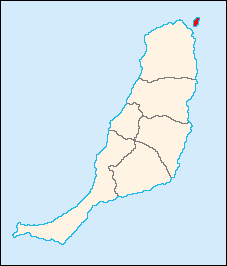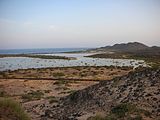Lobos (island)
| Lobos | ||
|---|---|---|
| Photo taken by NASA | ||
| Waters | Atlantic Ocean | |
| Archipelago | Canary Islands | |
| Geographical location | 28 ° 45 '0 " N , 13 ° 49' 16" W | |
|
|
||
| surface | 4.58 km² | |
| Highest elevation |
Montaña La Caldera 127 msnm |
|
| Residents | uninhabited | |
| Location north of Fuerteventura | ||
The uninhabited island of Lobos ( Spanish Islote de Lobos , Island of Robben ) is part of to Spain belonging to the Canary Islands in the Atlantic Ocean .
geography
The uninhabited island in the La Bocayna strait between Fuerteventura and Lanzarote is 4.58 square kilometers and thus has a share of 0.06 percent of the total area of all Canary Islands. In 1982 Lobos was placed under nature protection. The island is administered by the municipality of La Oliva on the island of Fuerteventura, two kilometers away, and has been part of the Corralejo Dune Park since 1987 . In 1994 Lobos was declared a Natural Park Parque Natural del Islote de Lobos . A good 130 plant species, some endemic, are protected here in two zones, namely areas that can be used by the general public and those that are designated as reserves and are not allowed to be entered. Lobos is also a bird sanctuary.
The highest point is the Montaña La Caldera with a height of 127 m . Lobos was formed 15,000 to 30,000 years ago together with the Volcanes de Bayuyo through volcanism on a fault line in the earth's crust and has since been separated from Fuerteventura by the rise in sea levels. The geology and history of origin are closely related to that of the large neighboring islands of Fuerteventura and Lanzarote.
There are several small passenger ferries from Corralejo to the small concrete pier El Muelle on Lobos. Hiking destinations include the Faro de Martiño lighthouse, the former volcano Montaña La Caldera , the sandy and bathing bay of Playa las Conchas , remains of the salt pans in the west, the small lagoons (lagunitas) in the northeast, salt marshes, which are home to salt-loving ( halophilic ) plants and the "volcanic ovens" ( Hornitos ) on the "rough land" (Malpaís) .
history
Archaeological excavations have been taking place on the beach of La Calera on Lobos Island since 2012. The finds indicate that there was a workshop for the production of purple from the sea snail Stramonita haemastoma . More than 60,000 shells of these animals have been found. Ceramic, metal and stone tools were used between the first century BC. And dated to the first century AD. The ceramics show similarities with pieces made in Gades, today's Cádiz , at the time . The complex could have been set up by the Romans or by King Juba II of Mauritania , who was appointed by the Romans .
When the French nobleman Jean de Béthencourt had subjugated Lanzarote in 1402 , he tried to take Fuerteventura from the neighboring island of Lobos, which he finally succeeded in 1405 after several attempts. The monk seals ( Spanish: Lobos Marinos = sea wolf) after which the island is named, were exterminated in the Canary Islands within the 15th century because the seafarers of that time used the meat, fat and fur of the animals.
In 1863, the Faro de Martiño lighthouse was built on the northern tip and put into operation two years later. The writer Josefina Pla was born there in 1903 and later lived in Paraguay . For some time, a few farming families settled on the island. Remains of their cisterns (aljibes) can still be found today. The last beacon keeper who lived there with his family had to leave in 1968 after the automation of the beacon. The lighthouse, which has since been restored, is still in operation today.
Today there are two restaurants near the pier in Casas del Puertito for day visitors. A few fishermen own weekend cottages there. There are no permanent residents.
photos
Individual evidence
- ↑ Spanish Statistics Office
- ↑ LA Cueto Pascual, R. Balcells Herrera, JL Barrera Morate: Mapa geológico de España . Scale 1: 25,000, sheet 1086 I / 1087 I – IV: Isla de Fuerteventura. Tostón-Corralejo . Instituto Geológico y Minero de España, Madrid 1990, ISBN 84-7840-501-1 , S 24. Accompanying booklet (PDF; 912 kB), accessed on April 5, 2018 (Spanish).
- ↑ Arco Aguilar et al .: Un taller romano de púrpura en los límites de la Ecúmene: Lobos 1 (Fuerteventura, Islas Canaria): primeros resultados . Ed .: Mª del Carmen del Arco Aguilar, Mª Mercedes del Arco Aguilar, Carmen Benito Mateo, Mª Candelaria Rosario Adrián. Museo Arqueológico de Tenerife, Organismo Autónomo de Museos y Centros, Cabildo de Tenerife, Santa Cruz de Tenerife 2016, ISBN 978-84-88594-83-9 , p. 518 (Spanish).







